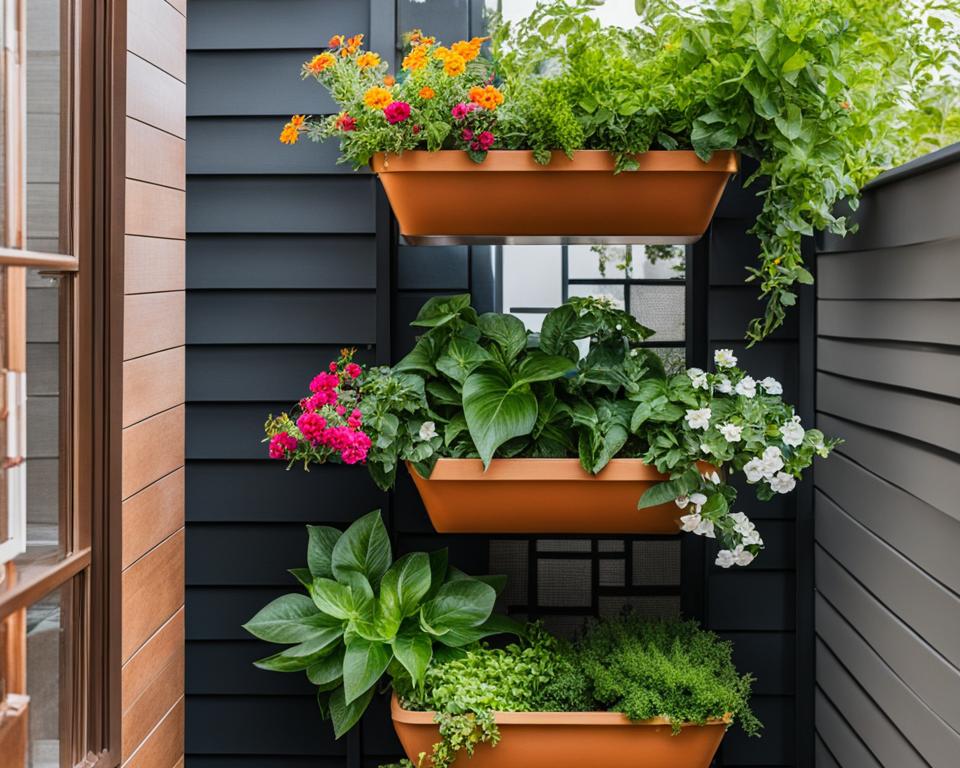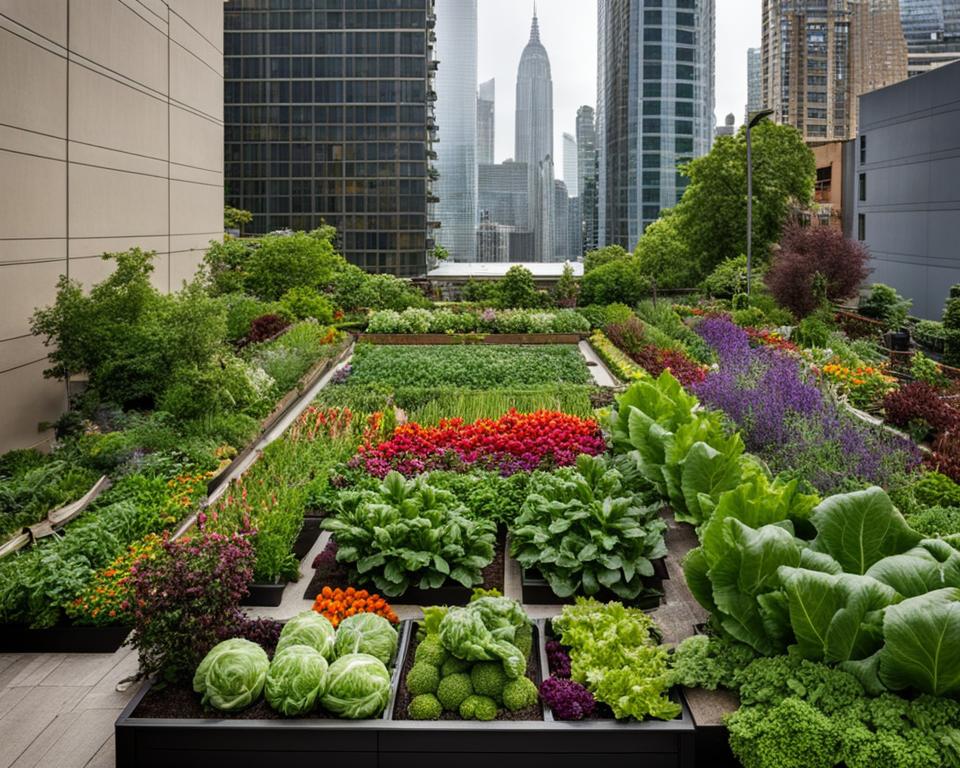Welcome to our beginner’s guide on how to start urban gardening! If you’ve always wanted to grow your own food but have limited space, urban gardening is the perfect solution. With a little creativity and planning, you can have a productive garden regardless of the space available to you. Whether it’s a backyard, side yard, rooftop, or even a community garden, urban gardening allows you to enjoy the benefits of homegrown produce in an urban setting.
Key Takeaways:
- Urban gardening is a great way to grow your own food in limited spaces.
- You can start urban gardening in various locations such as backyards, side yards, rooftops, or community gardens.
- With some creativity and planning, you can have a productive urban garden regardless of the space you have available.
- Urban gardening involves cultivating plants, particularly food-producing plants, in non-traditional spaces.
- By following the tips in this guide, you can start your urban garden and enjoy the benefits of fresh, homegrown produce.
What is Urban Gardening?
Urban gardening refers to the practice of setting up and maintaining a garden in urban or suburban spaces. It involves the cultivation of plants, particularly food-producing plants, in non-traditional gardening spaces such as rooftops, balconies, and small yards. The goal of urban gardening is to maximize limited space and produce food for personal use or community consumption.
Urban gardening ideas can include turning your backyard into an edible garden space, lining your driveway with edible plants, creating a rooftop garden, or joining a community garden. The possibilities are endless, and with a bit of creativity and planning, you can create a thriving urban garden regardless of the space you have available.
“Urban gardening allows individuals to take control of their food production and make a positive impact on their environment. It’s a way to connect with nature, reduce your carbon footprint, and promote sustainable living in urban areas.”
Benefits of Urban Gardening
There are numerous benefits to urban gardening. Here are just a few:
- Access to fresh, homegrown produce: By growing your own food, you have access to fresh and nutritious produce right at your doorstep.
- Environmental sustainability: Urban gardening promotes sustainable practices such as composting, using organic fertilizers, and conserving water, helping to reduce your ecological footprint.
- Health and well-being: Gardening has been shown to reduce stress, improve mental health, and provide a sense of accomplishment and fulfillment.
- Community engagement: Joining a community garden allows you to connect with like-minded individuals, share knowledge and resources, and contribute to the local community.
Urban gardening is a rewarding and sustainable way to grow your own food, regardless of the limited space available in urban areas. By embracing urban gardening ideas and practices, you can create a green oasis right at home, enjoy the benefits of fresh produce, and make a positive impact on your environment and community.
Tips for Creating an Urban Garden
Creating an urban garden can be a rewarding and fulfilling experience, providing you with fresh produce and a closer connection to nature. Here are some essential tips to help you get started on your urban gardening journey:
1. Understand and work with the space you have
Assess the available space for your urban garden and take note of how much sunlight it receives. It’s also important to be aware of any rules or regulations you need to follow, such as restrictions on plant height or the use of certain gardening tools.
2. Plan your garden layout
Consider the types of plants you want to grow and plan their placement accordingly. Explore vertical gardening techniques, which involve growing plants upward using trellises or stakes to maximize space. Additionally, opt for dual-purpose plants that serve multiple functions, such as herbs that also repel pests.
3. Choose the right soil, fertilizer, and seeds
Select soil that is appropriate for the plants you intend to grow. Consider using organic fertilizers to promote healthy growth and minimize environmental impact. When choosing seeds, opt for varieties that are well-suited to your specific growing conditions and climate.
4. Provide appropriate care for your plants
Just like any other garden, urban gardens require proper care to thrive. Ensure your plants receive the right amount of water, sunlight, and nutrients they need to flourish. Monitor your garden regularly, checking for signs of pests, diseases, or nutrient deficiencies.
- Regularly water your plants, taking care not to over or under-water them. Adjust your watering schedule based on weather conditions and the moisture needs of your plants.
- Apply organic fertilizers according to the instructions provided, giving your plants the nutrients they require for healthy growth.
- Keep an eye out for any signs of pests or diseases and take appropriate action to protect your plants.
By following these tips for creating an urban garden, you can set yourself up for success and enjoy the abundant rewards of your own thriving green oasis in the heart of the city.
Small Space Gardening Techniques
In urban gardening, space is often limited. However, that doesn’t mean you can’t have a thriving garden. With some creative small space gardening techniques, you can make the most out of your available space and enjoy a bountiful harvest. Here are some ideas to help you maximize your small urban garden:
- Vertical gardening: Utilize vertical space by growing plants upward. Use trellises, stakes, or hanging planters to support climbing plants and free up valuable ground space.
- Square foot gardening: Divide your growing area into square foot units to ensure efficient use of space. This method allows you to grow a variety of plants in a small area while making plant care and harvesting easier.
- Dense planting: Plant densely to maximize every inch of available space. Choose plants that can be grown close together without hindering their growth, such as leafy greens or herbs.
- Companion planting: Pair plants that have mutually beneficial relationships. For example, planting marigolds with tomatoes can help repel pests, while tall plants can provide shade for sun-sensitive crops.
- Container gardening: Grow plants in containers or pots, which are perfect for small spaces like balconies or patios. This allows for easy movement and gives you control over the growing environment.
“Even in small spaces, you can still have a productive and beautiful garden. Just get creative and make the most of every nook and cranny.”
Small Space Garden Ideas
Here are some small space garden ideas to inspire you:
- Create a vertical herb garden on your kitchen wall using hanging planters.
- Transform a small balcony into a lush oasis by utilizing containers and vertical space.
- Use a window sill to grow compact herbs or dwarf vegetables.
- Install a trellis along a fence and grow climbing vegetables like peas or cucumbers.
- Make use of vertical gardening pockets to grow strawberries or trailing flowers on a sunny wall.
No matter how small your space may be, there are endless possibilities for creating a beautiful and productive urban garden. Get started with these small space gardening techniques and watch your garden flourish!

Urban Gardening Goals
Setting goals for your urban garden is an important step in creating a successful and fulfilling gardening experience. By establishing clear objectives, you can stay motivated and focused on achieving the results you desire. From designing your garden space to enjoying the benefits of urban gardening, here are some goals to consider:
- Design and layout garden space: Have a clear plan for your urban garden layout, including designated areas for different plants and features. This will help maximize your available space and create an organized and aesthetically pleasing garden.
- Grow a variety of vegetables and herbs: Aim to grow a diverse range of vegetables and herbs to provide a variety of fresh produce for yourself and your family. Experiment with different plant varieties to expand your culinary options.
- Practice sustainable gardening methods: Implement environmentally-friendly practices such as composting, using organic fertilizers, and conserving water. Minimizing waste and supporting a healthy ecosystem are important goals for any urban gardener.
- Create a community garden: Consider getting involved in or starting a community garden to connect with other urban gardeners and contribute to the local community. Sharing knowledge, resources, and produce can foster a sense of unity and collaboration.
- Enjoy the benefits of urban gardening: Embrace the physical, mental, and emotional benefits of urban gardening, including stress relief, improved well-being, and a closer connection to nature. Take the time to appreciate the beauty and tranquility of your garden oasis.
Setting Goals for Urban Gardening
When setting goals for your urban garden, it’s important to be realistic and adaptable. Start with a few achievable objectives and gradually expand as your confidence and skills grow. Regularly reassess and adjust your goals as needed to accommodate changes in your circumstances or preferences. Remember, the ultimate goal of urban gardening is to create a thriving and sustainable green space that brings joy and nourishment to your life.

“Setting goals is the first step in turning the invisible into the visible.” – Tony Robbins
By embodying this quote and setting clear goals for your urban garden, you can transform your vision into a flourishing reality. Stay passionate, stay committed, and enjoy the journey of urban gardening!
Importance of Gardening Books and Research
Gardening books and research are invaluable resources for urban gardeners. They provide a wealth of information, tips, and guidance that can help you make informed decisions and avoid common pitfalls. Whether you’re a beginner or an experienced gardener, books offer a treasure trove of knowledge on various aspects of urban gardening, from plant selection to pest control.
“Gardening books are like a gardener’s best friend. They offer practical advice, inspiration, and expert insights that can take your urban garden to the next level.” – Garden Guru
Books cover a wide range of topics, including urban gardening techniques, urban garden design, and climate-specific advice. They can help you understand the unique challenges and opportunities of gardening in an urban environment. Additionally, books often include beautiful photographs and illustrations that can inspire and guide you in creating a stunning urban garden.
Researching online is also an important resource for urban gardeners. Forums, videos, and articles provide a platform for sharing experiences and learning from experienced gardeners. You can connect with like-minded individuals, ask questions, and gain insight into the best practices for urban gardening. Online resources are constantly evolving and can keep you up to date with the latest trends and innovations in urban gardening.
Resources for Urban Gardening
When it comes to urban gardening, having access to reliable resources is key. Here are some recommended gardening books and websites to help you in your urban gardening journey:
- Book: “The Urban Gardener’s Guide: Growing and Harvesting Healthy Food in the City” by Jane Doe
- Book: “Urban Gardening 101: Tips and Techniques for Successful City Gardening” by John Smith
- Website: UrbanGardening.com – Offers a wide range of articles, videos, and tips for urban gardeners
- Website: CityGardenersForum.com – A community forum where you can connect with fellow urban gardeners and share advice
By utilizing these resources, you can enhance your knowledge and improve your urban gardening skills. Remember, the more you learn, the better equipped you’ll be to create a thriving and bountiful urban garden.
The Importance of Knowing your Hardiness Zone and Sunlight Exposure
When it comes to urban gardening, understanding your hardiness zone and the amount of sunlight your garden receives are crucial factors in determining the success of your plants. Your hardiness zone provides valuable information about the climate conditions in your region, helping you select plants that are well-suited to your area. By choosing plants that are adapted to your zone, you can ensure their healthy growth and increase your chances of a thriving urban garden.
Additionally, knowing the amount of sunlight your garden receives is essential for choosing the right plants. Some plants require full sun, while others thrive in partial shade or shade. By assessing the sunlight exposure in your garden, you can select plants that align with its conditions. This knowledge will help you create an optimal environment for your plants, ensuring they receive the appropriate amount of sunlight for their growth and development.
Choosing the right plants for your urban garden goes beyond personal preference – it is a strategic decision based on your hardiness zone and sunlight exposure. By considering these factors, you can maximize the chances of success and create a flourishing garden that is well-suited to your specific conditions.
Importance of Soil Preparation and Watering Techniques
Proper soil preparation and watering techniques are vital for the success of your urban garden. Soil preparation involves selecting the right type of soil for your plants and ensuring it has sufficient nutrients and good drainage. The quality of your soil directly impacts the health and productivity of your plants. Urban garden soil can be improved by incorporating organic matter such as compost or well-rotted manure to enrich its fertility. This will provide essential nutrients and encourage beneficial microbial activity in the soil.
Additionally, it’s important to test the pH level of your soil and make any necessary adjustments to ensure optimal growing conditions for your plants. Understanding the specific needs of your plants will help you determine the ideal pH range for your soil.
“Proper soil preparation and watering techniques are essential for creating a healthy growing environment for your plants.”
Watering techniques should be tailored to the specific needs of your plants. Overwatering can lead to root rot and other moisture-related issues, while underwatering can cause plants to wither and die. It’s essential to find the right balance and provide your plants with adequate moisture. The frequency and amount of watering will depend on factors such as plant species, soil type, and weather conditions.
To ensure efficient watering, consider using irrigation systems such as drip irrigation or soaker hoses. These methods deliver water directly to the plant’s root system, minimizing water waste and reducing the risk of fungal diseases. Mulching around your plants can also help retain soil moisture and reduce the frequency of watering.
Soil Preparation and Watering Techniques Checklist:
- Select the right type of soil and improve its fertility with organic matter.
- Test the pH level of your soil and adjust as needed.
- Understand the specific watering needs of your plants and provide adequate moisture.
- Consider using irrigation systems for efficient watering.
- Mulch around plants to retain soil moisture and reduce watering frequency.
By paying attention to soil preparation and watering techniques, you can create a healthy growing environment for your urban garden and set the stage for successful plant growth and abundant harvests.
Conclusion
In conclusion, urban gardening provides a fantastic opportunity to grow your own food, regardless of limited space. By following the tips and techniques explored in this beginner’s guide, you can confidently embark on your urban gardening journey. Remember to carefully plan your garden layout, making use of vertical gardening, square foot gardening, and container gardening techniques to maximize space. Choose plants suitable for your hardiness zone, and provide the right soil, fertilizer, and care to help them thrive.
Small space gardening techniques such as vertical gardening, companion planting, and dense planting can help you make the most of your limited space. Additionally, setting goals for your urban garden, practicing sustainable gardening methods, and enjoying the benefits of urban gardening will enhance your experience and connection to nature.
Don’t forget that gardening books and research are valuable resources to expand your knowledge and help you succeed in your urban garden. By understanding your hardiness zone and sunlight exposure, you can choose the right plants for your garden. Proper soil preparation and watering techniques are also essential for a healthy and productive urban garden. With patience, dedication, and the right approach, your urban garden can flourish and provide you with fresh, homegrown produce. Happy gardening!
FAQ
What is urban gardening?
Urban gardening refers to the practice of setting up and maintaining a garden in urban or suburban spaces, growing plants in non-traditional gardening spaces like rooftops, balconies, and small yards.
How do I start an urban garden?
To start an urban garden, assess your available space, plan your garden layout, determine your hardiness zone, choose the right soil and seeds, and provide appropriate care for your plants.
How can I make the most of small spaces in urban gardening?
You can make the most of small spaces in urban gardening by utilizing techniques such as vertical gardening, square foot gardening, dense planting, companion planting, and container gardening.
What are some goals I can set for my urban garden?
Some goals you can set for your urban garden include designing and layouting garden space, growing a variety of vegetables and herbs, practicing sustainable gardening methods, creating a community garden, and enjoying the benefits of urban gardening.
How can gardening books and research help in urban gardening?
Gardening books and research provide valuable information, tips, and resources to help make informed decisions and avoid common mistakes in urban gardening. They cover topics like urban gardening techniques, plant selection, pest control, and climate-specific advice.
Why is it important to know my hardiness zone and sunlight exposure for urban gardening?
Knowing your hardiness zone helps you determine which plants will thrive in your area, while understanding your sunlight exposure enables you to select plants that require the appropriate amount of sunlight for healthy growth.
Why is soil preparation and watering techniques important for urban gardening?
Proper soil preparation involves selecting the right type of soil for your plants and ensuring it has sufficient nutrients and good drainage. Watering techniques should be tailored to the specific needs of your plants to provide the right amount of water without over or under watering.

